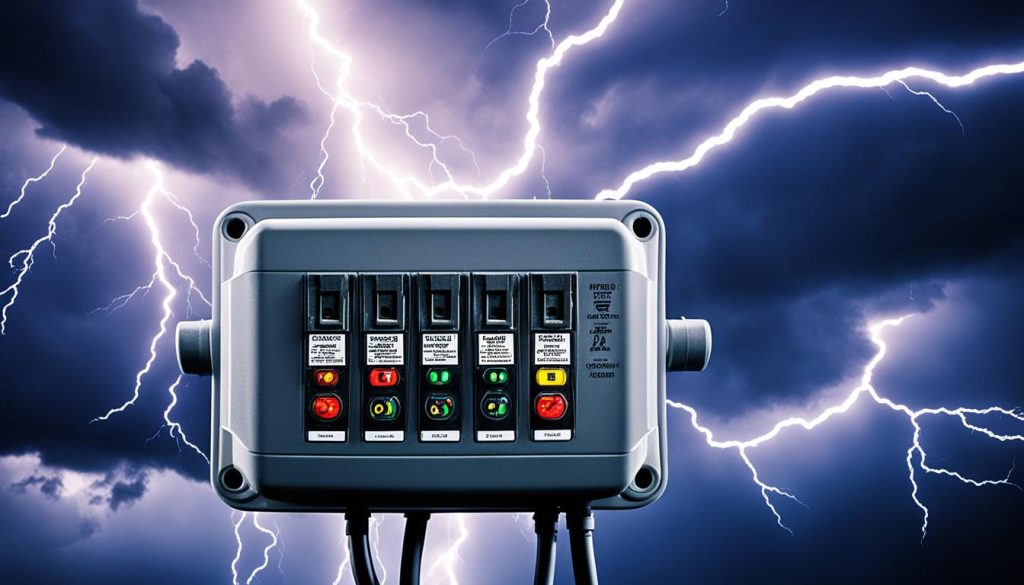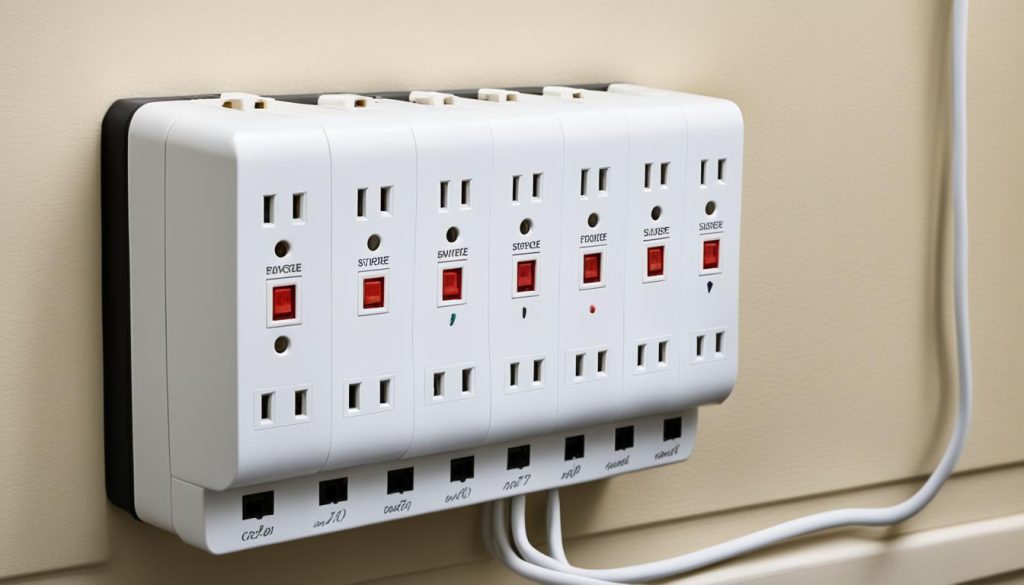When it comes to protecting your electronic devices from the damaging effects of power surges, surge protectors are a popular choice. But what about lightning strikes? Can surge protectors safeguard your electronics in the event of a thunderstorm? Let’s separate fact from fiction and shed some light on the topic.
- Surge protectors cannot provide 100% protection against direct lightning strikes.
- Surge protectors are effective in protecting against internal and external power surges.
- Whole-home surge protectors and point-of-use surge protectors are recommended for comprehensive protection.
While surge protectors are designed to divert excess voltage into the ground and safeguard against power surges, they cannot handle the massive surge of electricity generated by a direct lightning strike. Lightning strikes can produce up to one billion volts of electricity, which surpasses the capabilities of surge protectors.
However, surge protectors are still valuable in protecting against internal power surges that occur when larger appliances shut off, causing a brief increase in voltage throughout your home’s wiring. They also guard against external power surges caused by downed power lines during thunderstorms.
For comprehensive lightning protection, it is recommended to use both whole-home surge protectors and point-of-use surge protectors. Whole-home surge protectors are installed at your main electrical panel and provide protection against external and internal power surges. Point-of-use surge protectors, on the other hand, are designed to protect individual appliances.
While surge protectors offer valuable defense against power surges, it’s important to note that they cannot provide full protection against lightning strikes. To safeguard your electronics from lightning, consider installing whole-house surge protectors or suppressors at your main electrical panel. These devices are specifically designed to suppress large power surges caused by lightning that enter your home through the power lines.
Can Surge Protectors Safeguard Electronics from Lightning Strikes?
Surge protectors play a crucial role in protecting our electronics and appliances from power surges. However, when it comes to lightning strikes, their effectiveness has limitations. Lightning carries an astounding amount of electricity, often reaching millions of volts, far exceeding what surge protectors can handle. While surge protectors are designed to mitigate the impact of power surges caused by lightning, they cannot fully safeguard electronics during a direct lightning strike.
“Surge protectors cannot offer complete protection against lightning strikes.”
To truly protect your electronics from lightning strikes, it’s recommended to employ whole-house surge protectors or suppressors. These devices are installed on the main electrical panel of your home and can effectively suppress large power surges caused by lightning that enter through the power lines. By integrating them into your electrical system, you create a robust defense against lightning-related damage.
“Whole-house surge protectors provide the best defense against lightning-related power surges.”
It’s important to understand that surge protectors and suppressors have different functionalities. While surge protectors can handle power surges caused by various sources, suppressors are specifically engineered to handle the massive surge of electricity during a direct lightning strike.
| Surge Protectors | Suppressors |
|---|---|
| Effective against power surges from various sources |
Specifically designed for direct lightning strikes |
| Protects electronics and appliances | Offers comprehensive protection for the entire electrical system |
| Installed at individual outlets | Installed on the main electrical panel |
“Surge protectors and suppressors serve different purposes.”
While surge protectors are an essential component of a comprehensive protection strategy, it’s crucial to incorporate whole-house surge protectors or suppressors in areas prone to lightning strikes. By doing so, you significantly reduce the risk of lightning-related damage to your valuable electronic devices and appliances.
Unplugging Electronics during Lightning Storms: Myth or Truth?
Unplugging electronics during lightning storms is a common practice that aims to protect your devices from power surges caused by lightning. When lightning strikes near local electric poles, it can generate a sudden surge of electricity that can surpass the voltage limits of most electronic devices, potentially causing irreversible damage.
“Lightning is a powerful natural force that can pose a serious threat to our electronics. Taking precautions to minimize the risks is crucial for the safety of our devices.”
While it is true that power surges due to lightning strikes are relatively rare, it is still advisable to unplug high-ticket electronics like televisions and gaming consoles during thunderstorms. These expensive devices are particularly susceptible to power surges, and it’s better to be safe than sorry.
However, it is worth noting that unplugging the refrigerator during a lightning storm may not be necessary. Refrigerators are equipped with built-in surge protectors, which can help mitigate the risk of damage to the appliance. Leaving it plugged in reduces the risk of food spoilage during extended power outages.
To reduce the risk of electrocution, it is important to unplug your electronic devices before a thunderstorm approaches. Lightning can potentially strike your home or nearby power lines, sending hazardous electrical currents through the wiring. By unplugging your devices, you eliminate the possibility of electric shock and protect yourself and your loved ones.
Takeaway:
While surge protectors provide an additional layer of safety for your electronics, unplugging them during lightning storms remains a prudent measure. By unplugging high-ticket electronics and following basic safety precautions, you can safeguard your devices from the unpredictable nature of lightning and ensure their longevity.

The Difference Between Power Strips and Surge Protectors
In the world of electrical devices and protection, power strips and surge protectors are often used interchangeably. However, it’s important to understand that these two products serve different purposes and offer varying levels of protection.
Let’s start with power strips. These affordable devices are primarily designed to provide multiple outlets for your devices. They offer convenience by allowing you to plug in several devices at once, but they do not provide any real protection against electrical issues. Power strips are simply an extension of your wall outlets, giving you more options to connect your electronics.
On the other hand, surge protectors, also known as surge suppressors, go beyond providing additional outlets. They offer a level of protection against power surges, including those caused by lightning. Surge protectors work by diverting excess electricity, such as voltage spikes and surges, away from your devices and into the grounding wire.
Surge protectors come in various types and sizes, and their level of protection can differ. It is important to choose surge protectors with a higher joule rating, as this indicates their ability to handle larger or multiple power surges. Higher joule ratings offer better protection for your valuable electronics.
Unlike power strips, surge protectors are more elaborate and larger in size. They are equipped with additional features such as LED indicators to show if the surge protection is functioning properly, and some even include phone and cable line connectors to safeguard against surges from those sources as well.
Key Differences Between Power Strips and Surge Protectors:
| Power Strips | Surge Protectors |
|---|---|
| Provides multiple outlets for devices | Offers protection against power surges |
| Affordable | Vary in price depending on features and level of protection |
| No built-in surge protection | Equipped with surge protection mechanisms |
| Mainly for convenience | Protects valuable electronics from power surges |
| Simple design | More elaborate and visually distinguishable |
Overall, it is crucial to understand the difference between power strips and surge protectors. While power strips offer convenience by providing additional outlets, surge protectors offer real protection against power surges, including those caused by lightning. So, if you want to safeguard your electronics from unpredictable electrical surges, opt for a surge protector with a higher joule rating for enhanced protection and peace of mind.

Important Considerations when Choosing Surge Protectors
When it comes to protecting your valuable electronics from lightning surge, choosing the right surge protectors is crucial. Consider these factors:
- Joule Rating: Look for surge protectors with a higher joule rating, as it indicates their ability to handle larger or multiple power surges. A higher joule rating provides better lightning surge protection, safeguarding your devices against harmful voltage spikes.
- Connected Equipment Warranty: For added peace of mind, opt for surge protectors that come with warranties on connected equipment. Such warranties offer financial protection and ensure that if your devices are damaged due to an electrical surge, you can get compensation.
- Number of Outlets and Spacing: Consider the number of outlets and their spacing on the surge protector. Make sure there are enough outlets for all your devices, and check the spacing to accommodate devices with bulky plugs. This will ensure maximum usability and convenience.
- USB Connections: Some surge protectors also feature USB connections for charging your mobile devices. However, check the output amp rating of the USB ports to ensure they provide quick and efficient charging for your smartphones, tablets, and other USB-powered devices.
- Replacement Timeline: Keep in mind that surge protectors wear out over time. As a general guideline, it is recommended to replace surge protectors every three to five years to maintain optimal surge protection capabilities.
- Phone and Cable Line Protection: For total protection against lightning surges, consider surge protectors that include connectors for phone and cable lines. This will safeguard your communication devices and prevent any damage caused by lightning strikes through these lines.
By considering these factors, you can select surge protectors that offer reliable surge protection against lightning strikes. Investing in high-quality surge protectors will not only mitigate the risk of electrical damage to your valuable electronics but also provide you with peace of mind during thunderstorms and power surges.
Choose wisely and ensure your devices stay safe!
FAQ
Do surge protectors protect against lightning?
Surge protectors are not designed to offer complete protection against direct lightning strikes.
Can surge protectors safeguard electronics from lightning strikes?
Surge protectors are effective in protecting against internal and external power surges, which are more common than direct lightning strikes.
Do I need to unplug electronics during lightning storms?
It is advisable to unplug high-ticket electronics like televisions and gaming consoles to minimize the risk of damage from power surges caused by lightning.
What is the difference between power strips and surge protectors?
Power strips provide multiple outlets, while surge protectors offer some level of protection against power surges.
What factors should I consider when choosing surge protectors?
It is important to consider the joule rating, warranty on connected equipment, number of outlets, spacing, and additional features like USB connections.


